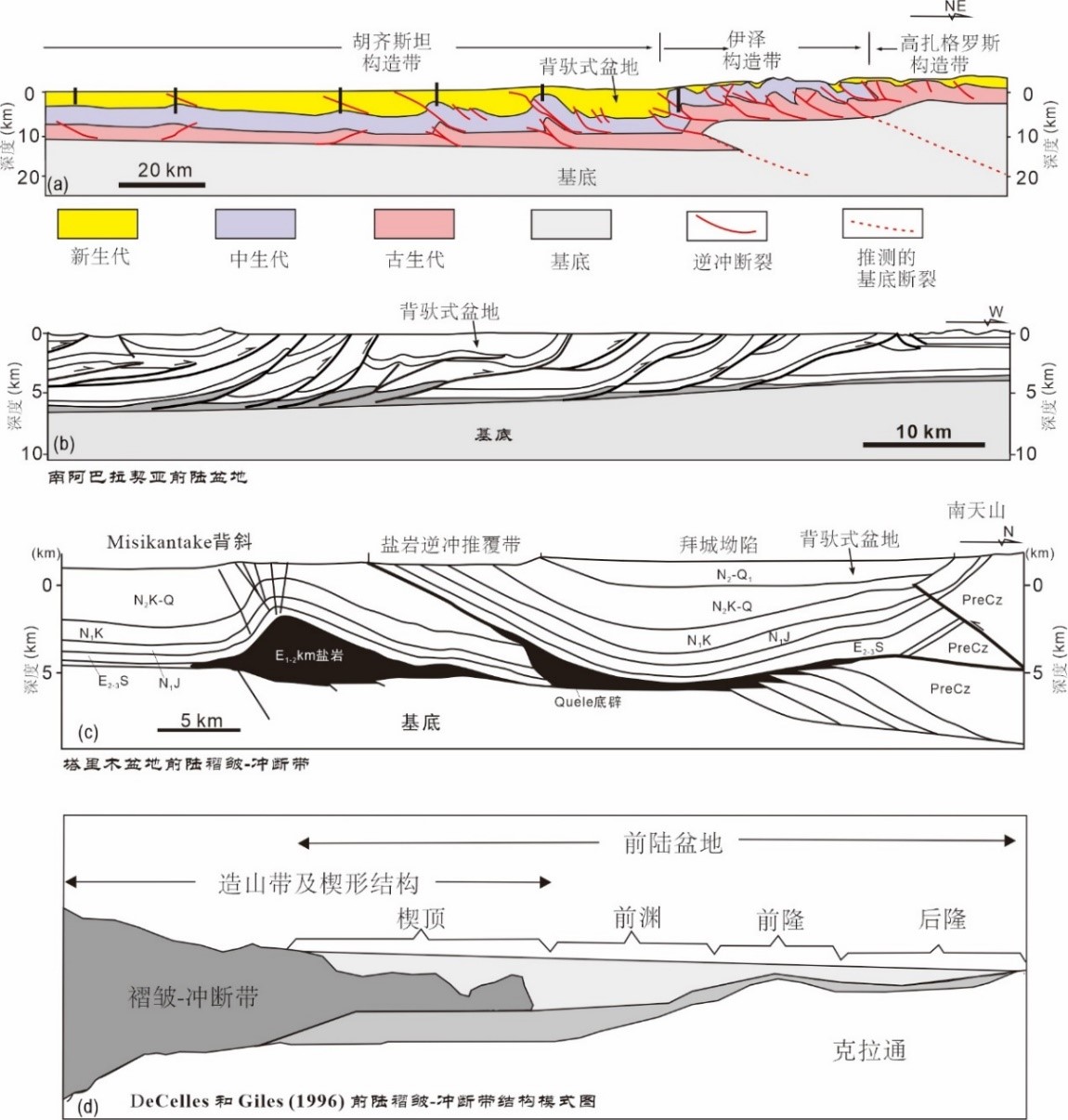博文
何文刚,余一欣等——基底摩擦属性和脆性层厚度对背驮式盆地地貌形态及形成演化的影响:来自物理模拟的启示
||
基底摩擦属性和脆性层厚度对背驮式盆地地貌形态及形成演化的影响:来自物理模拟的启示
何文刚1, 2 余一欣3 郑学贤4 周 杰1 江明倩1 罗丽虹1
(1. 遵义师范学院土木工程系 贵州遵义 563006;2. 葡萄牙里斯本大学科学院 葡萄牙里斯本 1749-016;
3. 中国石油大学(北京)油气资源与探测国家重点实验室 北京 102249;4. 中国石油集团
东方地球物理勘探有限责任公司海洋物探处 天津 300457)
摘 要 对背驮式盆地的形成机制进行分析有利于深入理解油气运聚成藏的过程及其机理,前人研究已基本揭示了背驮式盆地的构造几何学特征及可能的动力学来源,但有关背驮式盆地的形成机制及其控制因素的物理模拟探索,所开展的研究工作还不足。本文主要根据基底摩擦属性差异和脆性层厚度变化,设计了两个系列4组实验模型,对背驮式盆地的成因机制进行了分析和探讨。研究表明:1)脆性层厚度是控制背驮式盆地形成的关键因素,太薄的脆性层厚度不利于形成背驮式盆地,而较厚的脆性层有利于背驮式盆地的形成; 2)基底摩擦强度在一定程度上也影响背驮式盆地的形成,褶皱—冲断带根带基底高摩擦和前缘低摩擦强度,对背驮式盆地的形成具有促进作用;褶皱—前缘高摩擦强度则阻碍背驮式盆地的形成;3)只有根带具有较大的脆性层剪应力,同时前缘构造带具有较小的基底剪应力,在力学上具备一定的动力学平衡,才能形成形态较为清晰的背驮式盆地;4)四川背驮式盆地的形成与青藏高原的强烈隆升所提供较大的剪应力和川东构造带的基底具有软弱层,改变了该区的基底摩擦强度等密切相关。该研究成果对进一步深入理解背驮式盆地的形成演化具有重要的指示意义。
关键词 背驮式盆地 基底摩擦属性 脆性层厚度 地貌形态 演化特征 物理模拟
Effects of basal friction properties and thickness of brittle layer on geomorphic morphology and evolution of piggyback basin: New insights from analogue modelling
He Wengang1, 2 Yu Yixin3 Zheng Xuexian4 Zhou Jie1 Jiang Mingqian1 Luo Lihong1
(1. College of Engineering and Technology, Zunyi Normal University, Zunyi Guizhou 563006; 2. Departamen to de Geologia, Faculdade de Ci^encias, Universidade de Lisboa, Lisboa, Portugal 1749-016; 3. State Key Laboratory of Petroleum Resource and Prospecting, China University of Petroleum, Beijing 102249; 4. BGP INC., China National Petroleum Corporation, Tanggu, Tianjin 300457)
Abstract
Understanding the formation mechanism of a peripheral foreland basin is conducive to the exploration and development of petroleum and mineral resources in a fold-and-thrust belt, which has attracted extensive attention. In previous study, the structural geometric and possible dynamic characteristics of peripheral foreland basins were basically revealed. However, research on the formation mechanism and controlling factors of peripheral foreland basins remains insufficient. Therefore, according to the difference in the basal-friction properties and variations in the brittle-layer thickness, the formation mechanism of a peripheral foreland basin was analyzed and discussed using four groups of two sets of sand–silicone models. The results show the following. 1) The brittle-layer thickness is the key factor that controls the formation of a peripheral foreland basin. Too thin a brittle layer is not conducive to the formation of a peripheral foreland basin; only a thicker brittle layer can promote the formation of peripheral foreland basins. 2) The basal friction can change the structural style of a peripheral foreland basin. From the hinterland to the foreland of fold-and-thrust belt, the basal frictional force decreases, forming a piggyback basin. On the contrary, the strength of the basal friction of the foreland structure belt is too strong, and it will be difficult to form a piggyback basin. 3) Only when the hinterland of a fold-and-thrust belt is subjected to a large shear stress in the brittle layer, while the front structural domain carries a small shear stress in the basement and obtains a certain dynamic mechanical balance, a peripheral foreland basin with a clearly geomorphic morphology can be formed. 4) The formation of a peripheral foreland basin, such as the Sichuan basin, is closely related to the strong uplift of the Tibetan Plateau, which provides a large shear stress. Moreover, the basement of eastern Sichuan has a weak layer, which changes the basement friction strength in this area. The knowledge derived from our study is very important for further understanding the formation and deformation evolution of peripheral foreland basins.
Keywords Piggyback basin, Basal friction properties, The thickness of brittle layer, Geomorphic shape, Evolution characteristics, Analogue modelling
前陆盆地是位于造山带和稳定的克拉通之间的构造变形区域,而背驮式盆地是前陆盆地中比较常见的一类盆地。所谓背驮式盆地,是逆冲构造体系中,相邻的两逆冲板片之间形成的凹陷地带(Ori and Friend,1984;Chanvry et al.,2018)。前陆盆地分布面积比较广泛,在全世界各大山系的周缘几乎都有前陆盆地分布,如加拿大的卡尔加里前陆盆地、扎格罗斯褶皱—冲断带的前陆盆地、中亚阿姆河前陆盆地、中国新疆的库车前陆盆地、四川前陆盆地和青海的柴达木前陆盆地等(图1)。同时,前陆盆地因富集大量的油气和矿产资源而受到广泛关注。为此,前人对前陆盆地进行了广泛的研究(Davis et al.,1983;Sherkati et al.,2006)。在横向结构特征上,可以把前陆盆地分成典型的造山楔、前渊和前陆稳定克拉通区域(De Celles and Giles,1996)。同时,前人利用区域地质资料、地球物理和钻测井资料,清晰地揭示了部分前陆盆地的逆冲构造层序,前陆地区的地层、沉积相带分布和岩相组成等(De Celles and Giles,1996;Bonini,2007;Burchfiel et al.,2008;Wu et al.,2014)。在形成机制和动力学特征研究上,表明前陆盆地是受到造山带的挤压作用所形成。但是,并不是所有前陆褶皱—冲断带都可以形成背驮式盆地,而是需要具备一定的构造地质条件。到目前为止,对前陆盆地的形成和控制因素的模拟研究,前人开展了浅表构造、剥蚀、挤压方向、物质迁移沉积作用的相关研究(Graveleau et al., 2015;邓宾等, 2018,2022;Borderiea et al., 2019;Soto et al., 2020;Zuffetti and Bersezio, 2021)。但前人只是讨论了控制前陆盆地形成的主要因素,没有回答在什么条件可以形成前陆或者是背驮式盆地,相关的模拟研究仍然相对缺乏,尤其是背驮式盆地形成机制的物理模拟分析,仍有待于进行更深入的研究和探讨。

图1 背驮式盆地及前陆褶皱—冲断带结构模式图
a. 扎格罗斯前陆盆地结构特征(Sherkati et al., 2006);b. 南阿巴拉契亚前陆盆地结构特征(Davis et al., 1983);
c. 塔里木盆地前陆褶皱—冲断带结构特征(Wu et al., 2014);d. 前陆盆地结构特征模式图(De Celles and Giles, 1996)
Fig. 1 Structural model of the piggyback basin and foreland fold-thrust belt
物理模拟是当前研究造山带和前陆盆地比较有效的分析手段,它可以为理解前陆盆地的形成机制提供构造物理学证据(Graveleau et al.,2012;Buiter,2012)。为此,本研究在前人研究的基础上,根据基底摩擦属性和脆性层厚度,设计了2个系列4组石英砂和硅胶组合模型,对背驮式盆地的地貌特征及形成机制进行了研究探讨,为进一步理解前陆盆地的形成及变形演化过程提供重要的理论参考。
https://wap.sciencenet.cn/blog-400480-1358974.html
上一篇:陈邦学,徐胜利等——新疆东天山铁岭钼矿区含矿正长花岗岩的岩石成因:锆石U-Pb年代学、地球化学及Hf同位素约束
下一篇:张邦禄,张连昌等——西昆仑地区古生代沉积型铁锰矿床成矿规律及其与原—古特提斯洋演化的关系